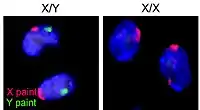Gametogenesis
Gametogenesis is a biological process by which diploid or haploid precursor cells undergo cell division and differentiation to form mature haploid gametes. Depending on the biological life cycle of the organism, gametogenesis occurs by meiotic division of diploid gametocytes into various gametes, or by mitosis. For example, plants produce gametes through mitosis in gametophytes. The gametophytes grow from haploid spores after sporic meiosis. The existence of a multicellular, haploid phase in the life cycle between meiosis and gametogenesis is also referred to as alternation of generations.
| Part of a series on |
| Sex |
|---|
 |
| Biological terms |
| Sexual reproduction |
|
| Sexuality |
In animals
.svg.png.webp)
Animals produce gametes directly through meiosis from diploid mother cells in organs called gonads (testis in males and ovaries in females). Males and females of a species that reproduce sexually have different forms of gametogenesis:
- spermatogenesis (male)
- oogenesis (female)
Stages
However, before turning into gametogonia, the embryonic development of gametes is the same in males and females.
Common path
Gametogonia are usually seen as the initial stage of gametogenesis. However, gametogonia are themselves successors of primordial germ cells (PGCs) from the dorsal endoderm of the yolk sac migrate along the hindgut to the gonadal ridge. They multiply by mitosis, and, once they have reached the gonadal ridge in the late embryonic stage, are referred to as gametogonia. Once the germ cells have developed into gametogonia, they are no longer the same between males and females.
Individual path
From gametogonia, male and female gametes develop differently - males by spermatogenesis and females by oogenesis. However, by convention, the following pattern is common for both:
| Cell type | ploidy/chromosomes in humans | DNA copy number/chromatids in human[Note 1] | Process |
| gametogonium | diploid (2N)/46 | 2C before replication, 4C after 46 before, 46 × 2 after | gametocytogenesis (mitosis) |
| primary gametocyte | diploid (2N)/46 | 2C before replication, 4C after 46 before, 46 × 2 after | gametidogenesis (meiosis I) |
| secondary gametocyte | haploid (N)/23 | 2C / 46 | gametidogenesis (meiosis II) |
| gametid | haploid (N)/23 | C / 23 | |
| gamete | haploid (N)/23 | C / 23 |
In vitro gametogenesis
In vitro gametogenesis (IVG) is the technique of developing in vitro generated gametes, i.e., "the generation of eggs and sperm from pluripotent stem cells in a culture dish."[1] This technique is currently feasible in mice and will likely have future success in humans and nonhuman primates.[1]
In gametangia
Fungi, algae, and primitive plants form specialized haploid structures called gametangia, where gametes are produced through mitosis. In some fungi, such as the Zygomycota, the gametangia are single cells, situated on the ends of hyphae, which act as gametes by fusing into a zygote. More typically, gametangia are multicellular structures that differentiate into male and female organs:
- antheridium (male)
- archegonium (female)
In flowering plants
In angiosperms, the male gametes (always two) are produced inside the pollen tube (in 70% of the species) or inside the pollen grain (in 30% of the species) through the division of a generative cell into two sperm nuclei. Depending on the species, this can occur while the pollen forms in the anther (pollen tricellular) or after pollination and growth of the pollen tube (pollen bicellular in the anther and in the stigma). The female gamete is produced inside the embryo sac of the ovule.
Meiosis
Meiosis is a central feature of gametogenesis, but the adaptive function of meiosis is currently a matter of debate. A key event during meiosis is the pairing of homologous chromosomes and recombination (exchange of genetic information) between homologous chromosomes. This process promotes the production of increased genetic diversity among progeny and the recombinational repair of damage in the DNA to be passed on to progeny. To explain the adaptive function of meiosis (as well as of gametogenesis and the sexual cycle), some authors emphasize diversity,[2] and others emphasize DNA repair.[3]
Notes
- Sources are mixed when using this system of numbering. Some sources use the chromatid number when writing "n" rather than the ploidy number. Hence gametogonium and primary gametocyte would be "4n" rather than "2n" with "4c" for copies. The system used below has been determined by wikipedia consensus and should not necessarily be used as the definitive source on the issue.
References
- Cohen, Glenn; Daley, George Q.; Adashi, Eli Y. (January 11, 2017). "Disruptive reproductive technologies". Science Translational Medicine. 9 (372). doi:10.1126/scitranslmed.aag2959. Retrieved January 16, 2017.
In vitro gametogenesis (IVG)—the generation of eggs and sperm from pluripotent stem cells in a culture dish. Currently feasible in mice, IVG is poised for future success in humans and promises new possibilities for the fields of reproductive and regenerative medicine.
- Harrison CJ, Alvey E, Henderson IR (2010). "Meiosis in flowering plants and other green organisms". J. Exp. Bot. 61 (11): 2863–75. doi:10.1093/jxb/erq191. PMID 20576791.
- Mirzaghaderi G, Hörandl E (2016). "The evolution of meiotic sex and its alternatives". Proc. Biol. Sci. 283 (1838). doi:10.1098/rspb.2016.1221. PMC 5031655. PMID 27605505.